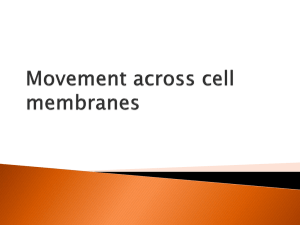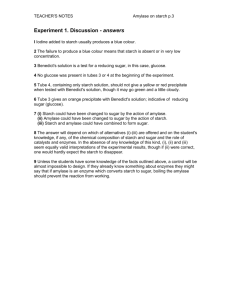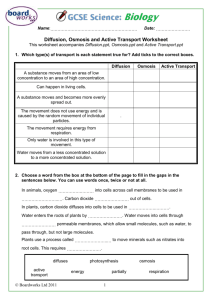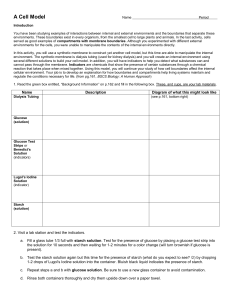Guidance Leaflet XX Title
advertisement
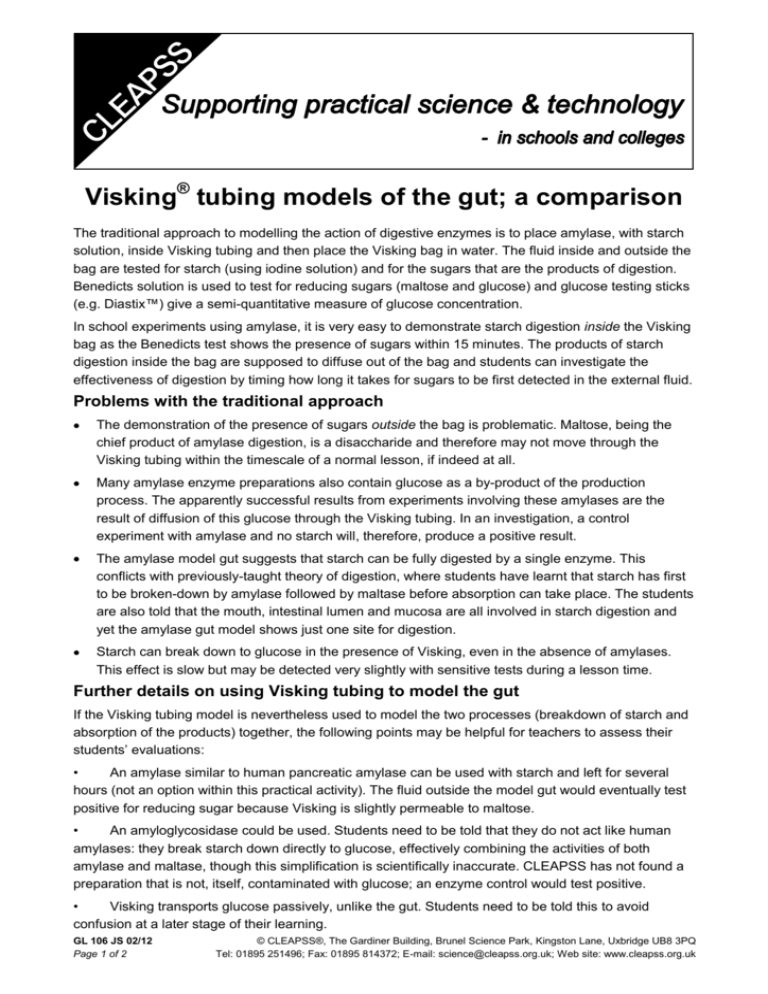
Visking® tubing models of the gut; a comparison The traditional approach to modelling the action of digestive enzymes is to place amylase, with starch solution, inside Visking tubing and then place the Visking bag in water. The fluid inside and outside the bag are tested for starch (using iodine solution) and for the sugars that are the products of digestion. Benedicts solution is used to test for reducing sugars (maltose and glucose) and glucose testing sticks (e.g. Diastix™) give a semi-quantitative measure of glucose concentration. In school experiments using amylase, it is very easy to demonstrate starch digestion inside the Visking bag as the Benedicts test shows the presence of sugars within 15 minutes. The products of starch digestion inside the bag are supposed to diffuse out of the bag and students can investigate the effectiveness of digestion by timing how long it takes for sugars to be first detected in the external fluid. Problems with the traditional approach The demonstration of the presence of sugars outside the bag is problematic. Maltose, being the chief product of amylase digestion, is a disaccharide and therefore may not move through the Visking tubing within the timescale of a normal lesson, if indeed at all. Many amylase enzyme preparations also contain glucose as a by-product of the production process. The apparently successful results from experiments involving these amylases are the result of diffusion of this glucose through the Visking tubing. In an investigation, a control experiment with amylase and no starch will, therefore, produce a positive result. The amylase model gut suggests that starch can be fully digested by a single enzyme. This conflicts with previously-taught theory of digestion, where students have learnt that starch has first to be broken-down by amylase followed by maltase before absorption can take place. The students are also told that the mouth, intestinal lumen and mucosa are all involved in starch digestion and yet the amylase gut model shows just one site for digestion. Starch can break down to glucose in the presence of Visking, even in the absence of amylases. This effect is slow but may be detected very slightly with sensitive tests during a lesson time. Further details on using Visking tubing to model the gut If the Visking tubing model is nevertheless used to model the two processes (breakdown of starch and absorption of the products) together, the following points may be helpful for teachers to assess their students’ evaluations: • An amylase similar to human pancreatic amylase can be used with starch and left for several hours (not an option within this practical activity). The fluid outside the model gut would eventually test positive for reducing sugar because Visking is slightly permeable to maltose. • An amyloglycosidase could be used. Students need to be told that they do not act like human amylases: they break starch down directly to glucose, effectively combining the activities of both amylase and maltase, though this simplification is scientifically inaccurate. CLEAPSS has not found a preparation that is not, itself, contaminated with glucose; an enzyme control would test positive. • Visking transports glucose passively, unlike the gut. Students need to be told this to avoid confusion at a later stage of their learning. GL 106 JS 02/12 Page 1 of 2 © CLEAPSS®, The Gardiner Building, Brunel Science Park, Kingston Lane, Uxbridge UB8 3PQ Tel: 01895 251496; Fax: 01895 814372; E-mail: science@cleapss.org.uk; Web site: www.cleapss.org.uk Possible solutions to this dilemma • If the above points are taken into account, a microbial amylase such as the NCBE fungal amyloglycosidase AMG could be used. However, as this preparation contains glucose, an ‘enzyme only’ control will test positively for glucose or reducing sugar. AMG is probably more suitable for qualitative models or for investigations in which the loss of starch, but not the production of glucose, is being tested. • The disaccharidases invertase or lactase could be used as alternatives digestive enzymes to study. Invertase breaks down sucrose to glucose. Sucrose is a non-reducing sugar, so samples tested for reducing sugars before incubation would give a negative result. Lactase breaks down lactose to glucose and galactose. Preparations of both these enzymes are available, and the products of microbial versions are the same as for the human enzymes. Milk may be used as a source of lactose. The issue of the mechanism of transport of the glucose across the Visking tubing would nevertheless still apply. See guidance leaflets GL103 and GL107 for possible methods. Teachers need to trial the activities (as is anyway advisable) and if they proceed with a method, decide the extent to which students are able to cope with the limitations of the various models suggested. However if these points are discussed and considered within the students’ evaluation, any of these activities could make fascinating investigations for testing higher-level investigative skills. A comparison of models of the gut and carbohydrates/carbohydrases Details of model Intended to model: Comments A mixture of starch and glucose inside Visking tubing. That small molecules can pass through the gut wall but large ones can’t. Both the starch and glucose can be tested. This may suggest that students could observe the breakdown of starch into sugars. Further to the above, that amylase breaks down starch into smaller molecules that can pass through the gut wall. Again, the starting materials and end products can be tested, showing starch broken down and (it is hoped) glucose getting through the Visking. That lactase breaks down lactose into smaller molecules that can pass through the gut wall. Lactases and microbial beta-galactosidases act similarly. Samples uncontaminated with glucose are available. Milk can be used as a source of lactose. That invertase breaks down sucrose into smaller molecules that can pass through the gut wall. Microbial and human versions produce the same products. Samples uncontaminated with glucose are available. Sucrose is a non-reducing sugar, so both the starting mixture and the end product can be tested for reducing sugars. Test fluids inside and outside Visking for sugar and starch over time. Starch and amylase inside Visking tubing. Test contents of Visking and surrounding fluid for sugar and starch over time. Lactose and lactase inside the Visking tubing. Test internal and external fluid for reducing sugar over time. (See GL103.) Sucrose and invertase inside the Visking. Test internal and external fluid for reducing sugar over time. (See GL 107.) GL 106 JS 02/12 Page 2 of 2 Problems: Visking not a direct model for active transport through the gut wall, but this can be used as a simple introduction to digestion. Problems: Mammalian amylases do not break starch down to glucose; the products do not get through Visking tubing quickly. Fungal amylases may do so but samples available to schools are contaminated with glucose. Problem: A specific test for glucose is helpful, because lactose is a reducing sugar and would also test positive using eg, Benedict’s solution. © CLEAPSS®, The Gardiner Building, Brunel Science Park, Kingston Lane, Uxbridge UB8 3PQ Tel: 01895 251496; Fax: 01895 814372; E-mail: science@cleapss.org.uk; Web site: www.cleapss.org.uk
